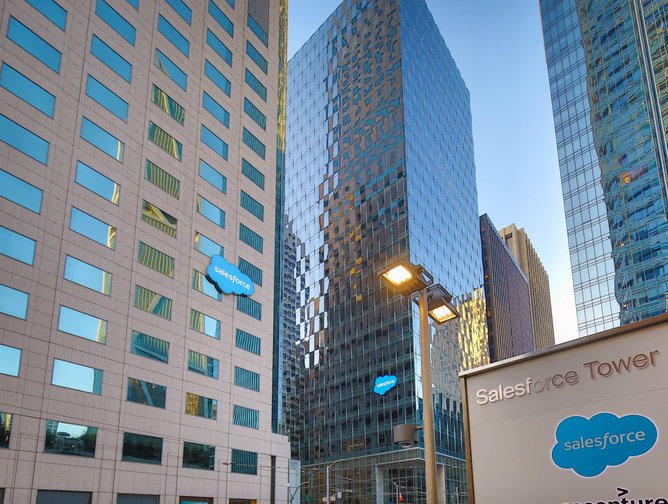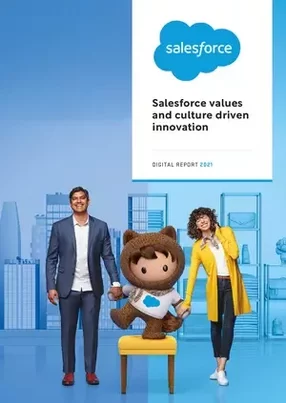Much has changed at Salesforce. Still best known as a CRM company, there’s a strong case for relabelling it as a cloud company. And its tendrils continue to stray as it buys companies in AI, data, and location software. Recent acquisitions of note include 2019’s takeover of data visualisation company, Tableau and, late last year, productivity wunderkind Slack.
It’s an internal transformation of focus that moves Salesforce away from being a tool-based solution towards a wider brief that emboldens the idea that the company could become a one-stop shop for digital transformation with CRM at its core. With customers featuring large on the strategy blackboard, that’s a compelling proposition, one that could see Salesforce as a major force entering a new era of enterprise technology.
Engagement buzz
For Adam Spearing, field CTO and VP consulting at Salesforce, the changes can be seen in the conversations he holds with customers. “I draw the difference between people who want to use our technology to solve their problems versus our customers who want to work with us and our technology to change their business. It’s a very different model. I get a huge buzz out of sponsoring and engaging with those kinds of organisations.”
Spearing divides these two attitudes to business technology as ‘renovating’ and ‘transforming’. For him, there’s only real value in renovating as part of a wider transformation.
Rethinking the model
It’s well publicised that the Covid-19 pandemic has accelerated digital transformations globally, something Spearing has seen first hand both with customers and internally at Salesforce. “This past 18 months has been a challenge,” he accepts. “It’s caused us all to throw everything up in the air and really, really think about what we do and how we do everything. Our whole operating model had to be rethought – Salesforce is no different – and we’ve gone through looking at all the capabilities we were planning to bring to market to help customers. At the very beginning of [the pandemic] our product teams very quickly went through and said ‘what are the things that are going to help customers during the next, however long it’s going to be? How do we bring them forward? How do we deprioritise the things that are not going to help?’ So we restructured our whole roadmap of capabilities.”
With Salesforce’s customers clawing for solutions to a world that had changed virtually overnight, the product teams raced to build and release products to allow organisations to find their business feet early on. “We know that those that came with us early in those journeys rode out that storm much better than others,” Spearing observes.
An evolution
He also notes that the storm hasn’t passed yet. “We’re still in a very precarious – but improving – position and I think what a lot of organisations have realised is that being digital, being digitally led both for your customers and employees, is critical to survival. And we can’t say: ‘here’s the playbook’. What we want is to be able to help them work through this, make their organisations stronger, serve their customers better, make sure their employees are well looked after and able to do their jobs. That’s been a really interesting evolution of Salesforce, of what we are as an organisation. Helping people through this pretty horrendous time for everyone on the planet.”
It has helped that the need for seamless communication and connectivity to a rapidly dispersed workforce came at a time of unprecedented innovation in enterprise technology. It also helped that adoption of remote working joined the mainstream. “It is very, very clear that a large number of the workforce want the flexibility and the benefits of digital work-from-anywhere tools,” says Spearing. Beyond the productivity and connectivity solutions that are the most visible technological assets in this transition, he also sees the emergence of AI as a pivotal piece of the future work-from-anywhere life.
1 Billion predictions a day
“Our Einstein technology is doing around a billion predictions a day,” he explains. “So if I was working in a call centre and having to work from home, our technology automatically allows people to make that flip without having to go through some laborious process, and to do it in a very secure way because of the nature of the Salesforce technology. That was already inside what we did, and now the AI is able to help those people. It’s like a personal assistant, helping them to prioritise their work.”
Last year the announcement that Salesforce was buying Slack for US$27.7bn rocked the technology world. It’s a Silicon Valley megadeal and one that cements Salesforce’s position among the elite grade of global technology companies. That’s a relationship that has now started to bear fruit, and Spearing is excited about the possibilities. “This is about making things easier, faster, more seamless, less friction – Slack is going to allow people to do their jobs really well, and collaborate and communicate faster.”
But it is culture and mindset that are really driving business transformations, and that applies not only to Salesforce’s customers, but to Salesforce itself. “When I get the privilege and pleasure of meeting with C-level executives, I’ll talk about our culture and values more than our technology,” Spearing says. “The technology does grow and evolve over time, but actually the culture of this company is one of its core USPs. It’s who we are and what we do.
“That shows up a lot in what we’re trying to achieve. We believe business can be the greatest platform for change. The technology is really exciting; I love it. I get a buzz from understanding it. But actually it’s what we do with the technology and who we are and why we’re doing it that’s more important for me.”
Values and culture
The values and culture, Spearing is convinced, will lead to further innovation and growth in Salesforce’s technology portfolio. In five years, he believes that technology will be vastly easier to use and adopt, not least because of a core tenet at the company embracing ease of use and reciprocal value. He points to his own household for an example of how technology can bridge different attitudes to technological engagement. “My kids love their phones and Instagram and Snapchat. Personally, I love doing my email on a big screen because my eyesight’s going. My wife is more of a mobile user. What you’re going to see is all of these channels becoming blurred. You’re going to see seamlessness in the way that people engage with technology. The channel will be independent of where that’s coming from. Organisations need to think about that ubiquity. The technology has always been a window for the customer into efficiency and how the company is run. The more seamless and smooth we can make that experience, the more we’ll create totally different new ways of working.”
For that to happen, Spearing insists we’ll need an army of technological skills. There is, he points out, “still a fear”. Bridging the divide means embracing a training culture that closes the digital skills gap, bringing a new generation of diverse individuals into the technology industry. Salesforce has its own digital reskilling tool – Trailhead – a free-to-use, self-paced, gamified training programme that works on any device and offers broad training in digital skills that goes beyond the company’s own technologies.
Working together
That’s not unique to Salesforce and Spearing has noticed that technology companies have come around to the idea that they do not exist in a vacuum. “There will always be competition,” he concedes, “but what I’ve seen is a maturing of the relationships between certain organisations. For example, we launched something recently called Hyperforce, which allows us to take the amazing Salesforce technology and put on an amazing Amazon or Google or Alibaba environment. We worked together with them.
“It also means we’ve been thinking about working together on how we co-create technologies that allow tighter, slicker, neater integrations. How do we get the best? That’s how I see these relationships changing in the industry – working together – but it has to be driven by the customer.”
For Spearing, that co-innovation – fused with the needs of particular business verticals – is driving the evolution of the partner ecosystem. Building towards the future requires working together in an environment of mutual trust and transparency. “Then you get this amazing magic that can happen in those ecosystems,” Spearing concludes. “That’s where those partnerships become crazily successful or make our customers successful. And, hopefully, we get a little bit of reflected glory somewhere along the way.”
As Salesforce drives forward atop a heap of technologies and possibilities, it’s easy to see how the company’s core values – trust, customer success, innovation and equality – stand it in perfect stead for the digital horizons of tomorrow.



